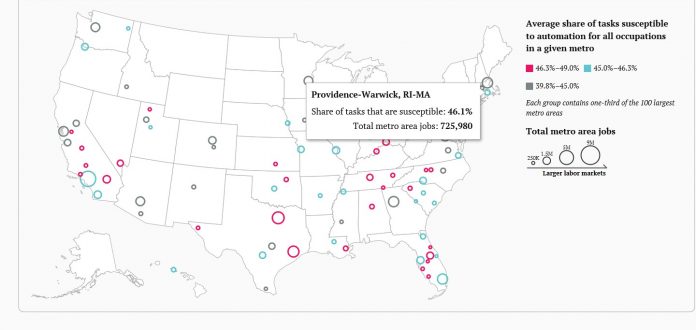
PROVIDENCE – A new report from the Brookings Institution released Thursday states that 46.1 percent of the average share of tasks in the Providence-Warwick-Fall River metropolitan area are susceptible to automation for all occupations by 2030.
The report, titled “Automation and Artificial Intelligence: How machines are affecting people and places” by Brookings’ Metropolitan Policy Program, analyzes the effects of automation on the U.S. workforce from 1980 to 2016 and how it will affect the economy moving forward through 2030. The report looks at the susceptibility of tasks in jobs that are potentially automatable.
In terms of average automation potential, the Providence metro ranks No. 39 out of the top 100 U.S. metros analyzed by the Brookings Institution, the highest of the seven New England metro areas studied in the report. The Toldeo, Ohio, metro, at 49 percent, has the highest automation potential, according to the study.
The report also breaks down its data by automation risk in three categories – low, medium and high. Low-risk jobs, according to the report, are those where 30 percent or less of tasks are potentially automatable, including management, education, social service, and arts/entertainment; medium-risk jobs have between 30-70 percent of tasks being automatable, such as construction, agriculture, health support, and sales; and high-risk jobs have more than 70 percent of tasks potentially being automatable, such as administrative and maintenance positions.
In the Providence metro, 38.9 percent of jobs will experience low-risk exposure, 35.8 percent of jobs will have medium-risk exposure and 25.3 percent of jobs will have high-risk exposure, Brookings found.
The study states automation and artificial intelligence will affect tasks in “virtually all occupational groups” in the future across the country, but the effects will be “of varied intensity.”
James Bessette is a PBN staff writer. Email him at Research@PBN.com.












